#latvian military
Text




Latvian troops at exercise Arrow 24 in Finland (May 2024)
0 notes
Photo
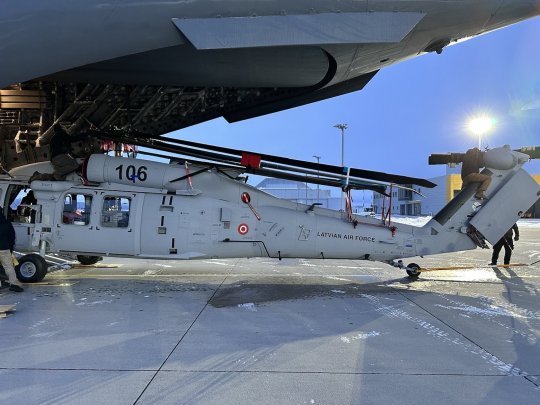
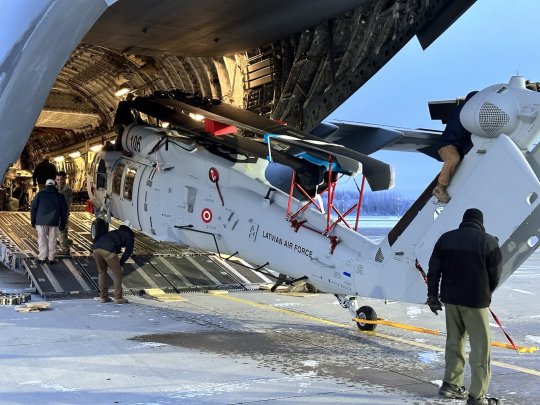
First two Sikorsky UH-60M Black Hawk helicopters delivered to Latvian Air Force, Latvia, December 11, 2022. Source: Ģenerālleitnants Leonīds Kalniņš
Quote: / DSCA, August 03, 2018 - WASHINGTON - The State Department has made a determination approving a possible Foreign Military Sale to Latvia of four (4) UH-60M Black Hawk Helicopters and related equipment for an estimated cost of $200 million.
The Defense Security Cooperation Agency delivered the required certification notifying Congress of this possible sale today.
The Government of Latvia has requested to buy:
- 4 UH-60M Black Hawk helicopters in standard USG configuration with designated unique equipment and Government Furnished Equipment (GFE),
- 10 T700-GE-701D engines (8 installed and 2 spares),
- 10 Embedded Global Positioning Systems/Inertial Navigation Systems (8 installed and 2 spares).
Also included is one (1) Aviation Mission Planning System, five (5) Talon Forward Looking Infrared Radar (FLIR) (4 production and 1 spare), ten (10) AN/ARC-201D/E (8 production and 2 spares), ten (10) AN/ARC-231 radios (8 production and 2 spares), five (5) AN/APX-123A Identification Friend or Foe (IFF) transponder (4 production and 1 spare), five (5) AN/ARC-220 Radio (4 production and 1 spare), twenty (20) AN/AVS-6 Helmet Mounted Night Vision Devices, aircraft warranty, air worthiness support, spare and repair parts, support equipment, communication equipment, publications and technical documentation, personnel training and training equipment, ground support equipment, site surveys, tool and test equipment, U.S. Government and contractor technical and logistics support services, and other related elements of logistics and program support.
The estimated total case value is $200 million./ Source: https://www.helis.com/database/news/latvia-uh-60m-black-hawk/
#Sikorsky UH-60M Black Hawk#helicopter#Latvia#Latvian Air Force#very good news#aviation history#NATO#defense of freedom#Allies#USA#military cooperation#Northern Europe
6 notes
·
View notes
Text
youtube
#youtube#militarytraining#Latvia#Change of Command#Military Exchange#NATO#Leadership Transition#1st Cavalry Division#Baltic Region#International Relations#Latvian Army#Military Tradition#US Army#Army Units#Military Parade#Military Protocol#Soldier's Ceremony#Epic Moments#Military Ceremony#Troop Rotation#Honor Guard#United States Military
0 notes
Note
not really a bomber jacket but I have something very close to one of these (miner's Greek) and can highly recommend it for your purposes of wanting to show off ass https://www.sportsmansguide.com/product/index/belgian-military-surplus-us-style-wool-ike-jacket-used?a=1884244
oh yeah Ike jackets, i have on from the ‘50s but the sleeves are a little long. used to wear it during highschool sometimes but it’s a little too overtly militaristic to wear all the time i think
#fun fact#former members of the latvian (i think) SS were conscripted by the US military after ww2 to guard the war criminals at nuremberg#and they were given all black uniforms including a black version of the Ike jacket#anonymous
0 notes
Text
Here's your daily reminder that...
Jews are only 0.2% of the worlds population but...
Jews make up 14% of the World Total and 38% of the United States of America total winners for the Nobel Prize for Literature (source).
Of the 965 individual recipients of the Nobel Prize and the Nobel Memorial Prize in Economic Sciences between 1901 and 2023, at least 214 have been Jews or people with at least one Jewish parent, representing 22% of all recipients. (source)
Jews make up 14% of the total winners of the Pulitzer Prize for Fiction 18% of the total winners of the Pulitzer Prize for Poetry; 53% of the total winners of the Pulitzer Prize for Non-Fiction (source).
Jews make up 39% of the total winners of the Antoinette Perry (Tony) Award for Best Play; 54% of the total winners of the Tony Award for Best Book of a Musical (with 62% of all Composers and 66% of all Lyricists of Best Musical-winning productions being Jewish) (source).
Jews make up 40% of the total winners of the Academy Award (Oscar) for Best Original Screenplay; and 34% of the total winners of the Academy Award for Best Adapted Screenplay (source).
Although Jews constitute only 3% of the U.S. population...
80% of the nation’s professional comedians are Jewish (source).
90% of American comic book creators are jewish (source)
38% of the recipients of the United States National Medal of Science are Jewish (Source).
Jews are very successful, with educational levels higher than all other U.S. ethnic groups with the exception of Asian Americans, and income levels the highest of all groups. Six out of ten Jewish adults have college degrees, and 41% of Jewish families report a household income of $75,000 or more” (source)
Jews are a minority across the globe. We've been historically opressed and hated. But these key figures from history are all Jewish and loved, yet many don't even know they're jewish (or they don't know these people in the first place!):
Stan Lee (birth name: Stanley Martin Lieber) - An American comic book writer and editor, Former executive vice president and publisher of marvel Comics, creator of iron-man, spider-man, and more.
Albert Einstein - a Theoretical physicist, Received the 1921 Nobel Prize in Physics, developed the theory of relativity and the "worlds most famous equation" (E = mc^2), and more.
Ruth Bader Ginsburg - Former Associate Justice of the Supreme Court of the United States, co-authored the initial law school casebook on sex discrimination, co-founded the Women’s Rights Project at the ACLU in 1972, and more.
Jack Kirby (birth name: Jacob Kurtzberg) - an American comic book artist, co-creator of Captain America, one of the most influential comic book artists
Harry Houdini (birth name: Erich Weisz) - a Hungarian-American escape artist, illusionist, and stunt performer, noted for his escape acts.
Emma Lazarus - An American author remembered for her sonnet "The New Colossus," Inspired by The Statue of Liberty and inscribed on its pedestal as of 1903.
Julius Rosenthal, Lillian Wald, Rabbi Emil G. Hirsch, Stephen Wise, and Henry Moskowitz - Jewish activists that helped form the NAACP along with W.E.B. Dubois, Ida B. Wells-Barnett, and Mary Church Terrell.
Mark Zuckerberg - Founder and CEO of Meta, a businessman who co-founded the social media service Facebook, and within four years became the world’s youngest self-made billionaire Harvard alumni.
Joseph Pulitzer - a politician and newspaper publisher, his endowment to the Columbia University established the Pulitzer Prizes in 1917, he founded the Columbia School of Journalism which opened in 1912.
Jacob William Davis - a Latvian tailor who is credited with inventing modern jeans and who worked with Levi Strauss to patent and mass-produce them, died.
Irving Berlin - drafted at age 30 to write morale-boosting songs for military revues (including “God Bless America”). Many Berlin songs remained popular for decades, including “Puttin’ on the Ritz,” “Cheek to Cheek,” “Anything You Can Do (I Can Do Better),” “There’s No Business Like Show Business,” and two celebrating Christian holidays: “White Christmas” and “Easter Parade.”
Rabbi Abraham Joshua Heschel - received his doctorate in Berlin. He was arrested by the Nazis in 1938, moved to the U.S. in 1940, and became an influential figure in the 1960s, marching with the Rev. Martin Luther King Jr. in Selma, Alabama, and speaking out against the Vietnam War.
Elie Wiesel - Romanian-American writer and professor, holocaust survivor, nobel laureate, political activist. Authored 57 books including Night, a work based on his experiences as a Jewish prisoner in the Auschwitz and Buchenwald concentration camps
Bob Dylan - an icon of folk, rock and protest music, won the Nobel Prize in literature for his complex and poetic lyrics.
J. Robert Oppenheimer - ran the Manhattan Project, considered the "father of the atomic Bomb," presented with the Enrico Fermi Award by President Lyndon Johnson.
Betty Friedan - co-founded the National Organization of Women and became its first president, wrote The Feminine Mystique (1963) and helped spark the second wave of feminism.
Gloria Steinem - one of the most prominent feminists of all time, launched Ms. Magazine and co-founded the National Women’s Political Caucus with Bella Abzug, Shirley Chisholm, Betty Friedan and Myrlie Evers-Williams, widow of Medgar Evers.
Sergey Brin - an American businessman best known for co-founding Google with Larry Page, president of Alphabet Inc.
Judith Heumann - a founder of the disability rights movement, led a 26-day sit-in at a federal building in San Francisco. The protest spurred implementation of Section 504 of the Rehabilitation Act, a precursor to the Americans with Disabilities Act.
Larry Kramer - co-founded Gay Men’s Health Crisis in response to the AIDS epidemic but was soon ousted over his confrontational activism. He went on to help launch a more strident group, ACT UP, and wrote a critically acclaimed play, The Normal Heart, about the early AIDS years in New York City.
Steven Spielberg - released his critically acclaimed epic film Schindler’s List, based on the true story of a German industrialist who saved Jews during the Holocaust. The movie won seven Oscars and led Spielberg to launch the Shoah Foundation at the University of Southern California, which filmed interviews with 52,000 survivors of the Holocaust and genocides in Nanjing and Rwanda.
Calvin Klein - made designer jeans and the infamous ad starring Brooke Shields revolutionized the fashion industry, sold his company to Phillips-Van Heusen (now PVH) for $430 million. Klein was the first designer to win three consecutive Coty Awards for womenswear.
Daveed Diggs - an American actor, rapper, and singer-songwriter. he originated the dual roles of Marquis de Lafayette and Thomas Jefferson in the musical Hamilton, for which he won a 2016 Tony Award for Best Actor in a Featured Role in a Musical. Along with the main cast of Hamilton, he was awarded a Grammy Award for Best Musical Theater Album in the same year.
And so much more. (a pretty decent list is available here)
Not only that, but the following are all Jewish inventions...
The Teddy Bear - made by Morris and Rose Michtom in honor of Theodore "Teddy" Roosevelt.
The Ballpoint Pen - *the first commercially sucessfull ballpoint pen was made by Lazlo Biro, a Hungarian-Jew, and his brother.
Mobile Phones - made by Martin Cooper, nicknamed the "father of the cellphone", and was born in Chicago to Ukrainian Jewish immigrants.
The Barbie - made by Ruth Marianna Handler, born to Polish-Jewish immigrants.
Power Rangers - made by Haim Saban, a Jewish-Egyptian
Video Games - made by Ralph Baer, a German-Jew
Peeps - made by Sam Born, a Russian-Jewish immigrants who came to the United States in 1909.
Cards Against Humanity - created by a group of Jewish boys from the same high school
Many Superheroes including Superman, Ironman, spider-man, batman, and more!
and more! (an illustrated list available here.)
Conclusion: If you're Jewish, be proud. You come from a long line of successful people. No matter what happened to them, Jews persevered, and they strived for sucess. Be proud of your culture, your history, these are your people. You're Jewish.
(feel free to reblog and add more, or just comment and i'll add it!)
Last Updated: June 25, 1:35 AM EST
#funkowrites#jumblr#jewblr#jewish tumblr#israel solidarity#judaism#jewish#antisemitism#stop antisemitism#op is a proud jew#proud to be jewish#jewish joy#jewish positivity#jew#proud jew#we will persevere
480 notes
·
View notes
Text
Salaspils: A Soviet Memorial To Nazi Victims In Latvia
Eighteen kilometres out of Riga, a series of stone giants stand frozen in a forest clearing to mark a place that some would rather forget.

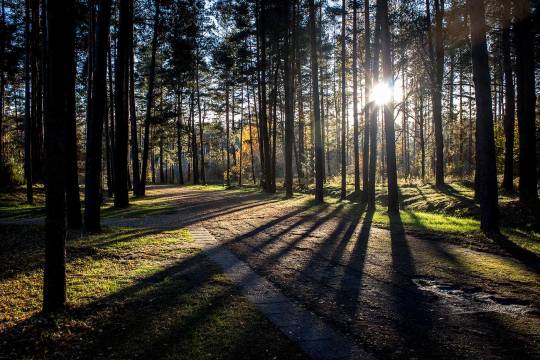
The forested approach to the Salaspils Memorial.
The road to the Salaspils Memorial Ensemble stops near the rail tracks, and visitors must walk the final stretch – through forests of pine, and birch that in autumn explodes into canopies of red and gold, the sunlight slicing sideways between trunks that shed their crisp white bark like snakeskin.
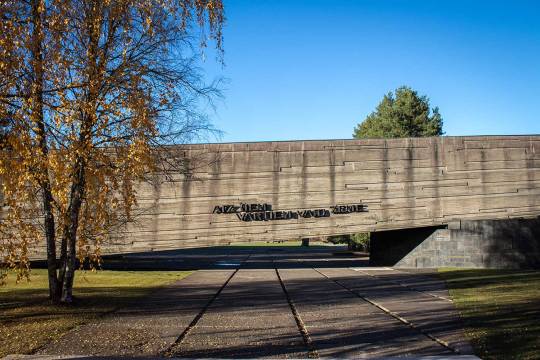
The gallery building measuring 100 metres long by 12.5 metres high.
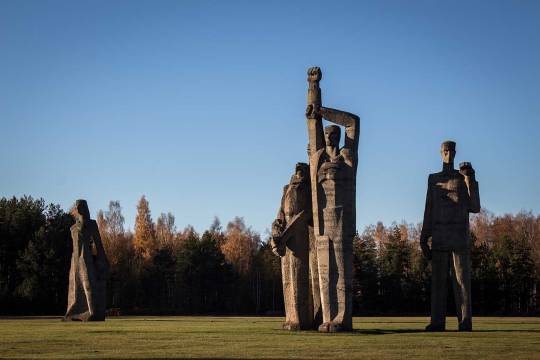
In the clearing beyond stands the Salaspils Memorial Ensemble.
The forest feels alive, almost supernaturally so, making it all the more abrupt to find the path suddenly barred by a looming concrete crossbeam, 100 metres long and more than 12 metres tall. This concrete barrier is a visitor building, an abstract Brutalist gallery that marks the symbolic threshold between life and death. It stands in the place where once there was a guardhouse ringed in barbed wire, the entrance to a former Nazi labour camp that operated for four years here amidst the picturesque Baltic birch. Through the arch, a clearing opens up between the trees; the camp barracks long gone, to be replaced by angular Soviet forms, towering, blocky figures stood as tall as the trees that surround them.
Above the entrance, a Latvian slogan is spelled out on the concrete flank of the gallery “Beyond these gates the land groans”, a line from a poem, written by a former prisoner of this place.

Part of the original wall of Camp Kurtenhof.
SS-Sturmbannführer Rudolf Lange, who was appointed in 1941 a commander of both the Nazi Security Service and the Security Police for occupied Latvia, that same year proposed the creation of a detention facility in the region. It was named Camp Kurtenhof, from the German name for the town of Salaspils, and located for convenience just off the main rail track between Latvia’s two largest cities: Riga and Daugavpils. It was designated a Police Prison and Labour Correctional Camp.

A symbolic tally etched into the gallery building counts time inside the prison.
Work on the camp began in late 1941, and it was built largely by the hands of Jewish prisoners deported from occupied Germany, Austria and Czechoslovakia. At least a thousand Jews were transported from the Riga Ghetto to join the construction team in January 1942. Offered little in the way of comfort, nutrition or sanitary facilities, they were overworked and many would die to that first harsh Baltic winter.
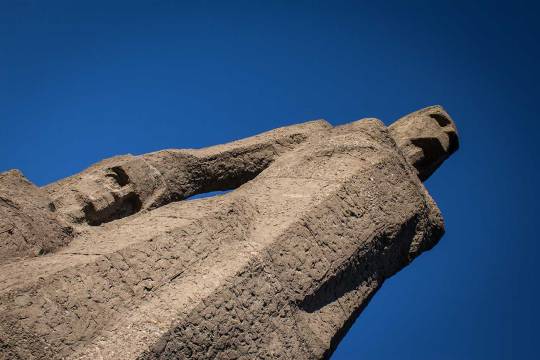
Symbols of Soviet defiance raised on the grounds of the former camp.
These workers were amongst the only Jews to ever set foot in the Salaspils camp. Unlike the Reich’s concentration camps, which answered to their own central administration in Berlin, the Police Prison Camp at Salaspils was under the direct control of local Security Police Commander Rudolf Lange. Its inmates were political prisoners and Baltic dissidents, expanding in summer 1942 to provide ‘labour correction’ to those caught avoiding work regulations; and from 1943 the camp began taking in Baltic police officers and military personnel convicted in SS courts. The Salaspils camp also operated as an intermediary transit camp for prisoners being transported from Belarus and Russia, to forced labour projects in Germany. A large number of children were imprisoned at the camp too, allegedly in dedicated children’s barracks.
youtube
By the later part of 1942 the camp consisted of 15 barracks that between them housed 1,800 prisoners. By summer 1943, there were 30 barracks. Prisoners here were involved in the digging and processing of peat, and according to survivors’ accounts, regardless of its specific ‘Police Prison’ designation, the organisation of work, and treatment of prisoners at Salaspils, was just as brutal as any of the other Nazi camps in the region.

From left to right: Solidarity, The Oath and Red Front.
The official website for the Salaspils Memorial states that, during its years of operation, roughly 23,000 people were imprisoned at the camp. It reports that from May 1942 until September 1944, up to 500 prisoners died of diseases, as many as 150 from exhaustion or brutal punishment regimes, and a further 30 were shot while attempting to escape. The younger prisoners were particularly susceptible to the diseases (such as measles and typhoid fever) that ran rife through the inmate population. It is believed that half the camp’s children died from illness, and after liberation, a mass grave was discovered containing the corpses of 632 children aged 5-9 years old. The Salaspils website suggests that, including the Jewish forced labourers who died during construction, the final death toll of the Salaspils camp stood at more than 3,000 people.

Left: The Unbroken; right: The Mother.
The Salaspils camp was liberated by the Soviets in September 1944. The fences were brought down, the barracks destroyed, but it wasn’t until two decades later that they constructed a grand memorial complex on the site where the camp once stood. A competition was held to select a design for the Salaspils Memorial Ensemble, as it was known, with the winning entry submitted by a team of seven: the architects Gunārs Asaris (who would also create the Monument to the Sailors and Fishermen Lost at Sea, at Liepāja), Oļģerts Ostenbergs, Ivars Strautmanis and Oļegs Zakamennijs, along with the sculptors Levs Bukovskis, Oļegs Skarainis and Jānis Zariņš. The park opened in 1967, and in 1970 its creators would receive the prestigious Lenin Award for their work – in the same ceremony that saw architect Yevgeny Vuchetich awarded for his famous monument at Volgograd: The Motherland Calls.
The opening ceremony was a grand, flower-laden affair, and the Salaspils Memorial Ensemble would go on to be considered one of the most important Soviet memorial sites in the Baltics.
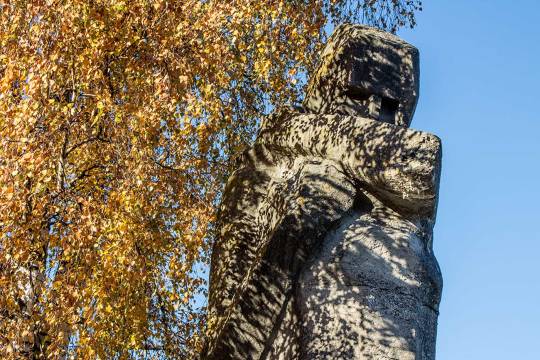
The sculpture called Humiliated.
Today it is not a particularly easy place to visit, and emerging from the trees into the clearing is a sobering moment. The simplicity of these concrete forms invites imagination. Instead of telling you what happened here, this place tries to make you feel it. I found myself reminded of my visit to Auschwitz – a visit I made on a warm summer’s day, birds singing, woodland flowers in bloom. If anything the setting for Salaspils was even more picturesque than that, and I felt a sense of emotional whiplash, after a while, constantly trying to square what I knew about this place with the information my senses were providing me.
The ensemble is built around nine concrete titans (in six installations), who tower over the neat lawns and were said to represent the different types of prisoner kept in the camp. ‘The Unbroken’ lies on his belly, pushing himself up with his last strength. ‘The Mother’ has a look of defiance, standing square to shield the infants that cower by her side. ‘The Humiliated’ kneels, her face partially hidden by an arm raised in a defensive gesture. In the very centre of the lawn, three forms are arranged side-by-side: ‘Solidarity’ shows one prisoner helping another to stand; ‘The Oath’ is a man stood tall stretching his arms into the air; while ‘Red Front’ likely represents a fighter from the paramilitary wing of the German Communist Party – the ‘Rotfrontkämpferbund’ – a group who used the same single-handed fist salute depicted here.
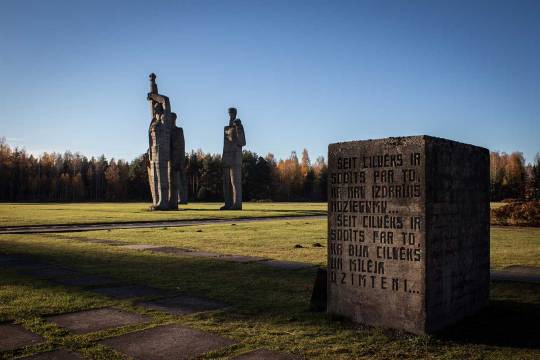
A memorial block where the camp’s gallows once stood.
The Salaspils Memorial features hardly a written word of information but that does not make it a quick place to visit. The monuments that decorate the lawn demand consideration. A single notable script appears on a stone block placed off to the right, between the central figures and the entry gate, marking the location of the former camp gallows. Its inscription in Russian and Latvian reads: “Here humans were executed for being innocent… Here humans were executed for every one of them being a human and loving the Motherland.”

Fragments of the original barrack walls.
At the opposite side of the Road of Death – as the designers named the walking path that circles their concrete giants – a black granite pedestal is designated as the place for laying flowers and memorial wreaths. From somewhere out of sight comes the ticking of a metronome. Intended to suggest life, and the eternal passage of time, the sound is rather like a heartbeat, and lends an uncanny atmosphere to my time amongst the statues.
The old camp buildings may be gone, but here and there, fragments of the outermost walls remain. Some are bare, but others are piled with tributes: plastic angels, Orthodox icons, a selection of sad-looking children’s toys. It feels like an effective memorialisation technique – bulldozing the camp, symbolically destroying its physical legacy, while leaving just enough of its form behind to suggest a historical record of its size and inner geography. Just a year before the Salaspils Memorial opened, the Yugoslav architect Bogdan Bogdanović had accomplished something similar at his Jasenovac Memorial Site, in what is now Croatia: the buildings of the old concentration camp were destroyed, but there, the ground was landscaped into mounds and craters that recorded the location and function of the various different buildings.

Text across the wall of the gallery “Beyond these gates the land groans.”
The only building at Salaspils now is the gallery – entered by an inclined walkway that passes through the length of the imposing concrete arch above the entrance. The space inside is oppressive and claustrophobic, presumably by design. This effect of sensory deprivation allows the visitor time to meditate, perhaps, and process the meaning of the monumental forms outside. When natural light does break through the side walls, it spills in at viewing slots reminiscent of wartime pillboxes. I peer outside, for a panoramic view of the figures on the lawn.
All the while, the sounds of the forest seem amplified as they reverberate though this enclosed space. There is birdsong, the noise of distant dogs barking, and somewhere nearby, where the original tracks cut lines through the trees, the shunting and hissing of cargo trains.

The walkway through the Brutalist gallery building.

The Salaspils Memorial Ensemble, seen from the gallery.
There is something inherently totalitarian about the form of remembrance prescribed by the Salaspils park. The sheer concrete, the lack of information. These twisted human figures tell visitors how they should feel, but the park never provided the tools for a two-way conversation. At Auschwitz visitors are shown piles of shoes, and suitcases, visual triggers designed to encourage an engagement with the numbers. At the National Museum of the Holodomor-Genocide in Kyiv, Ukraine, a similar effect was achieved with grains of corn – arranged in a heaped display where one grain stands for one Ukrainian life lost. Salaspils, in contrast, simply says: these people were punished for loving the Motherland.

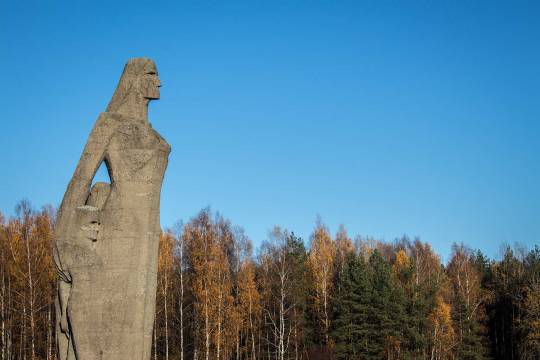
Commenting on the Soviet Union’s choice to memorialise Salaspils, Peter Hohenhaus notes how “other, even worse sites of the Holocaust such as Biķernieki received no commemoration at all.” It is perhaps no coincidence though, that the Soviets chose to create such a prestigious memorial over the remains of a camp which had less relation than most to the Jewish Holocaust. (Aside from the construction team, it is reported there were only 12 Jewish prisoners at Salaspils).
Following the war, the Soviet Union severely downplayed the significance of the Holocaust, to present the Soviet citizen, instead, as the chief target of Nazi aggression. Any specific commemoration of the Jewish tragedy was at least discouraged. For example there was a Holocaust memorial built in Minsk, Belarus, named ‘the Pit’; an obelisk on the site where 5,000 prisoners from the nearby Minsk Ghetto were executed by fascists in 1942. Its creators, the stonemason Morduch Sprishen and the poet Haim Maltinsky (who wrote the Yiddish inscription), were both later convicted on charges of Jewish nationalism, and after that, the authorities treated all visitors to the Pit memorial with suspicion. At Babyn Yar meanwhile, a ravine in Kyiv were tens of thousands of Jews were massacred, the victims of the Holocaust are still yet to be recognised with a proper memorial.
The USSR’s post-WWII efforts to ideologically bond its member republics through a shared sense of victimhood, and victory, was felt not least strongly in places like the Baltics – countries who were new Soviet subjects, and uneasy subjects at best. What better place then, for a grand Soviet memorial park, than Salaspils: a police camp that had chiefly housed antifascist Baltic dissidents, and Soviet citizens from Russia and Belarus. It was a place where Latvians and Russians had suffered together, side by side, and of all the dark places left to this region in the wake of Nazi occupation, this was the one whose memorialisation best supported the post-war political narratives of the Soviet Union.
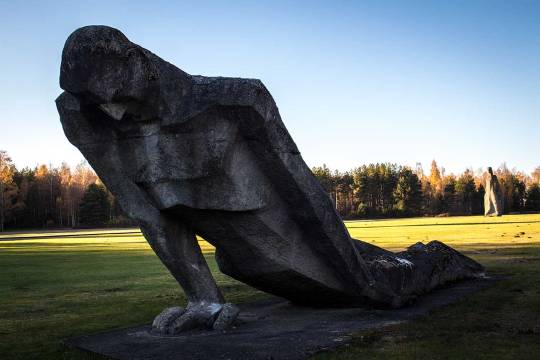
The Salaspils Memorial is recognised as part of the Latvian Culture Canon and in 2017, it was declared a monument of national significance. Despite this recognition however, it doesn’t feel like a place that is cherished, so much as observed. Visitors often report having trouble locating the place, and it hardly seems to be promoted as a tourist destination of note. When compared to videos showing the park’s opening ceremony (crowds of people, neatly trimmed lawns, and the forest pruned back around them), Salaspils today appears somewhat lonely and dishevelled.
Contemporary additions and modifications to the park have seemingly challenged the innate Sovietness of the place. A cemetery for German POWs was added in 2008, adjacent to the main memorial grounds. More recent is the installation of the Salaspils Memorial Exposition. Housed inside the Brutalist gallery building, the collection has been open to visitors since February 2018, and features information and video clips available in Latvian, German, English and Russian.
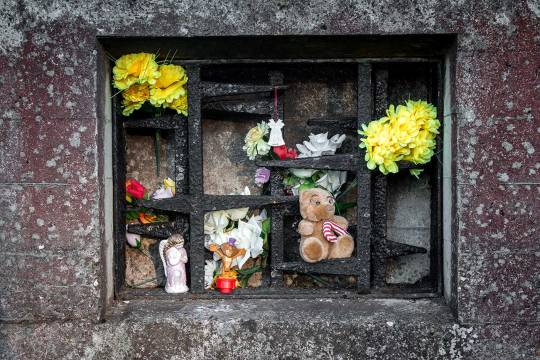

Tributes left by visitors to the Salaspils Memorial.
Elsewhere around the park, and dotted along the ‘Road of Death,’ new information panels have been installed to give context to the park’s otherwise sparse concrete symbolism. The memorial architecture of the park tells the story of Soviet people who fell victim to the Nazis. It is somewhat jarring then, to read contemporary panels that describe both Nazi Germany and the Soviet Union as “occupying regimes.” This is, of course, how the Latvians officially remember that portion of their history: as a violent occupation by a foreign power that would maintain a political and cultural stranglehold over Latvia for the next 45 years. If it seems strange to foreign visitors that a site as significant as this – and so close to the capital – should feel quiet, hidden away, and poorly advertised, then perhaps this is why: from a Latvian perspective, the Salaspils Memorial might very well feel like a monument built by one trespasser to present themselves as the chief victim of the previous one.
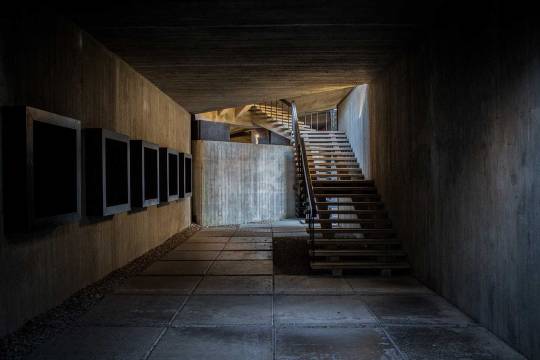
The main gallery space inside the visitors’ building. Below: the staircase inside the inclined viewing gallery.
According to the website, the new exhibition “provides visitors with information based on historical facts and the conclusions of the latest scientific studies,” in an effort to “dispel misconceptions about the Camp and the Memorial.”
Those “misconceptions” presumably include certain claims made in the Russian-language media. Many on that side of the border still believe the former Soviet account, which once stated that over 100,000 people had died at Salaspils (compared to the 3,000 cited today by the Latvians). There were stories, too, that the Nazis drained blood from children here to use in transfusions for German soldiers – though these seem to have since been largely debunked. Nevertheless, news outlets like RuBaltic.ru and Ukraina.ru accuse the park’s Latvian management of downplaying the numbers, rewriting history, and more generally of presenting the Nazi presence in Latvia as having been less harmful than that of the Soviets who liberated this camp. They refer to a new information panel at the Salaspils Memorial, which shows respective death tolls for the periods of Nazi and Soviet occupation; the Soviet number being the larger of the two.
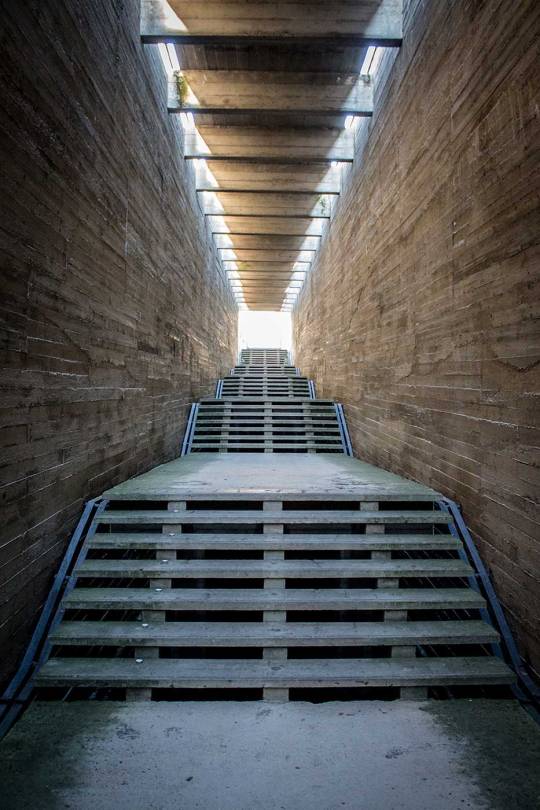
While obviously Latvia can and should be having these conversations, I can’t help but wonder if it isn’t slightly antagonistic (at least, to the ethnic Russians who make up a quarter of Latvia’s population), to have them here; to stand on the symbolic graves of dead Soviets while comparing them to the Nazis.

‘The Humiliated’ is partially hidden now, behind a tree not part of the original design for the memorial.
Memorials should serve a simple task, in theory: they remind us of things that we must not forget. They preserve important stories for those who were not there, and in societal terms, they serve to reclaim – to re-consecrate – ground once bloodied by violence. Danger zones become places of (re)education. But the invisible memory wars that continue to be waged across this quiet lawn in Latvia are anything but simple, and they hint at some of the greater cultural conflicts at large today in the post-Soviet Baltic states.
The last thing I saw before I left was another new, post-Soviet addition to the park. In 2004, a former prisoner at Salaspils named Larry Pik funded the creation of a new monument to the Jewish victims of the camp – the prisoners who built it. Accompanied by the Star of David, an inscription in Hebrew, German and Latvian reads: “To honour the dead and as a warning to the living. In memory of the Jews deported from Germany, Austria and Czechoslovakia, who from December 1941 to June 1942 died from hunger, cold and inhumanity and have found eternal rest in the Salaspils forest.”
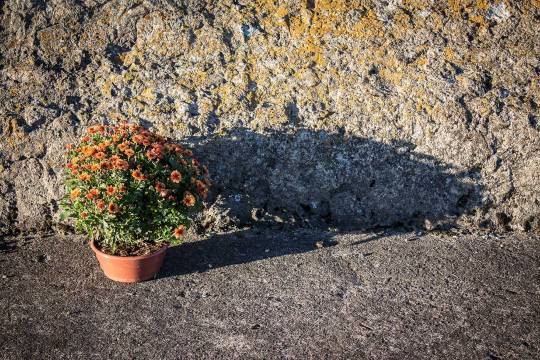
Flowers left in memory of the camp’s victims.

The cover of a 1969 commemorative book about Salaspils.
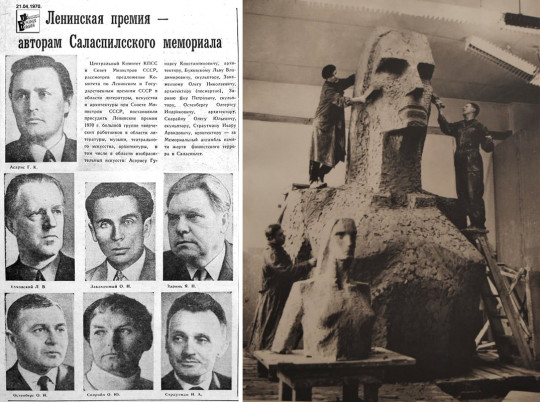
Left: a newspaper announces the Lenin Award given to the Salaspils design team. Right: ‘The Mother’ under construction.

‘The Unbroken,’ under construction, and then completed.
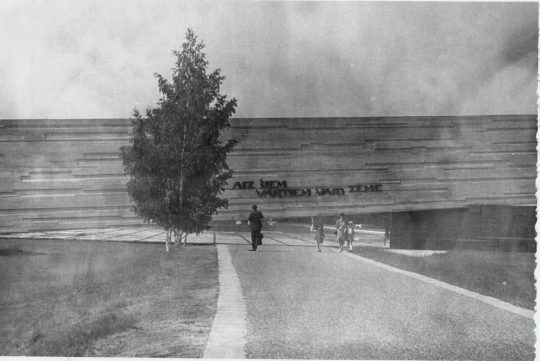
The gate to the Salaspils Memorial (late 1960s).
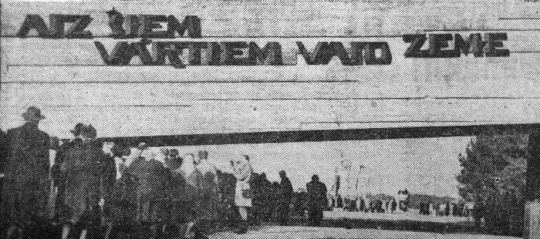
Visitors queue to enter (late 1960s).
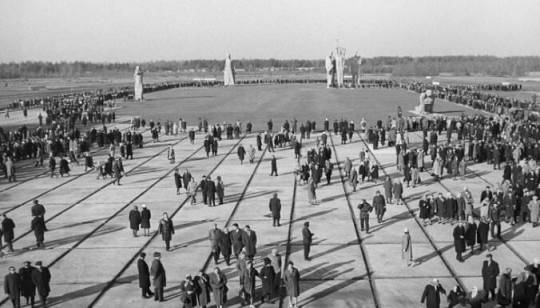
The memorial plaza at Salaspils (1968).

Left: Salaspils in 1975. Right: Cover of the 1985 Salaspils brochure.

The Salaspils Memorial Ensemble in 1970.
–
by Darmon Richter
[adapted with permission from an article at Ex Utopia]
249 notes
·
View notes
Note
As an Eastern Euro yourself how would you make the entire East Euro? (Since you said Himaruya screwed the whole region up). As someone who’s not from the region, my current thought is that if it were up to me there would be less blonds lol. Also: specific opinions on Russia, Ukraine and Belarus?
Yes, yes :D Less blonde I agree.
Russia - for me as a person who lives among them he's just... Too nice? Too well-behaved? Something like that. He needs just a little bit of spice, not too much. I would've also incorporated his sense of humor in some way, because it's a thing that is absolutely unique and IMO Russians have the best sense of humor in the world. And cartoons. Also his lack of organisation and general incompetence in EVERY SPHERE, I never saw that in Hetalia. Only his brutality. Shallow really. It must be there, that's what the Russians are mostly known for. Their main stereotype. He lacks carelessness
Belarus - I do get it. She's cold because of political reasons, only country in Europe to have death penalty... But I wish that she could also be warm. For example, yes, cold in the international arena, but comically warm and jolly among her friends. Belorussians are INSANELY nice and good people, like, I never met anyone on the same level. I absolutely love them and I am forever grateful to God for putting so many in my life. It's a miracle. I don't deserve this lol Also maybe a bit more play with Lithuania and Belarus, how he used to rule her, how she stole his coat of arms (xD), they're just a lot alike (same national bird etc). More spice in their relationship, not just Lithuania having a crush on her, but maybe accusing her of things, etc. Conversing about their love for potatoes. You know, things from everyday life that happen there.
Ukraine - Terrible. First of all, never met a Ukrainian without a tan in my life. They're reasonably positioned in southern Europe, the black sea... They're pretty dark although not all of them but I think it would be awesome if Bel and Russia were so pale and white and Ukraine tan but maybe still with blonde hair. It would contrast nicely. Tits, agreed. Poor gal? I don't think so, Ukrainians are quite strong and DEFINITELY NOT pushovers. What her design lacks are main events of Ukrainian history: Issues with Poland, nazi collaboration. Some edginess to her character. They're a bit nationalistic, but you can't blame them for it since how Russians and Poles treated them. (albeit they weren't exactly goodies either)
Latvia - I wish someone just read latvian history at least once in their lives. Just, one person, please. Hahaha. So basically, making Latvia more weak than Lithuania is a CRIME. At least more morally weak. Latvia had COLONIES, a great fleet, they were influenced with Germans, hence the better the development of his than that of Lithuania who was influenced by Slavs, LATVIA was the ONLY baltic state who fought the Nazis, who defended their country when they occupied them. Lithuania just let them in. He's just incredibly underrated, you can't just base his entire design on how he looks in 21st century. I'm not saying he's supposed to be buff and strong, because he is weaker in terms of military and sovereignty, but making him a woman I think would be very cool? Since the Latvian girls are the tallest in Europe. So making her tough in medieval times then making her weak in modern times would be pretty easy. They're way better than Lithuanians morally and behavior wise. Latvia is more liberal and easy going when it comes to ethnical issues, they don't really care that they're getting assimilated into Russia when Lithuania is really mean about it.
Lithuania - His name doesn't exist. The national clothes he's wearing in his design are incorrect, they look Ukrainian. Hair colour is very on point. Other than that, he has no right to be as nice as portrayed. They're usually mean and very passive aggressive. Terrible sense of humor. They're called the Italians of the North so that would be cool to see, making him the most emotional or in-your-face attitude out of all northerners.
It's not good that his love for singing, the entire basis of that country - singing, was never put into spot. I think it should be mainly based off that. More pagan stuff, they had remaining pagans up until the 19th century which is unbelievable, and that religion still exists now, people practice it. Also its a bit hard to speak of it as one country because there's like 5 regions there and people in each one of them differ a lot. Samogitians don't even consider themselves lithuanian.
Hungary is way too nice too. Their politics or history are not nice at all, they have an attitude of an oppressor. She looks too normal, there's not much hungarian about her, give her some special features. Should be made into a duo with Poland since they both call themselves brothers.
Slovakia - should never exist and should never deserve own design and appearance in the series. Die Slovakia
Poland - Gay weak inconsiderate irresponsible annoying and lame. So 100% accurate. Very nice, I agree, good job Hima.
Also it would be cool to see Königsberg in the series!
35 notes
·
View notes
Text
The british military is tormenting my princess
Natasha - Georgy Sviridov- interpretation, Vladimir Minin
(I tend to prefer the version from the Latvian Radio choir, on the album Sacred love (a masterpiece btw), but the mix is so fine that it didn't go well with the fried audio lmao)
Clips from the Ambassador of Death part 5 and 6
#doctor who#third doctor#jon pertwee#liz shaw#not enough of Liz Shaw actually she deserves her own edit#brigadier lethbridge stewart#professor cornish#classic who#my edits
7 notes
·
View notes
Text
NATO member state Latvia is installing anti-tank concrete pyramids, known as "dragon's teeth," along its border with Russia as part of an effort to defend against the country as tensions rise over the war in Ukraine, a video circulating on social media appears to show.
"Latvia has started installing defensive barriers on its border with Russia. The so-called 'dragon's teeth' were spotted near the easternmost Latvian town of Zilupe," Anton Gerashchenko, a former adviser to Ukraine's minister of internal affairs, said on X (formerly Twitter), sharing the footage.
Dragon's teeth, first used during World War II, are made of reinforced concrete and are used to impede the advances of tanks and mechanized infantry.
Newsweek couldn't independently verify when or where the footage was filmed.
Tensions between Russia and NATO have remained high throughout Russian President Vladimir Putin's invasion of Ukraine. Moscow has accused the alliance of involvement in the war by providing Kyiv with military assistance and weapons.
Russian officials have regularly floated the possibility that Russia could strike NATO members in response to the aid they have provided Ukraine with.
In January, the Baltic States—Latvia, Lithuania and Estonia—signed an agreement in the Latvian capital, Riga, to create a common defense line with "anti-mobility infrastructure elements" to bolster NATO's eastern border with Russia and Putin's ally, Belarus.
Latvia's Ministry of Defense told Newsweek that counter-mobility obstacles are being "procured and transported to temporary storage areas near Latvia's eastern border" in accordance with the Eastern Border Fortification and Counter-Mobility Plan, which was approved by the Latvian government on March 5.
"The obstacles will be set on the border according to the mentioned plan," the ministry said.
"From a military perspective, this initiative will significantly boost our capability to protect our borders at the national level; we will be able to slow down and block the movement of potential aggressors more efficiently," Latvia's Defense Minister Andris Sprūds said in a statement in January.
Sprūds added: "This is a joint project for Baltic countries, which will also advance NATO's collective defense."
Local publication tv3.lv reported in March, citing the country's defense ministry, that the defense line would include support points for the National Armed Forces units along the border; defensive positions for soldiers and fortified defensive positions; various obstacles; anti-tank ditches; ammunition and mine depots.

In April, Poland's Foreign Minister Radosław Sikorski said in an interview with German newspaper Bild that he "wouldn't be surprised at all" if Russia attacks his country. "Russia has attacked Poland many times in the 500 years of our history," he added.
"But, in this scenario, Russia will lose, because we, the West, are far more powerful than Russia," Sikorski said.
Serbian President Aleksandar Vučić said on Monday that he believed NATO member states were rapidly preparing for a potential war with Russia.
"They are not ready now, but I think they will be ready. They are already preparing for a conflict with the Russian Federation and are preparing much faster than some people would like to see, in every sense," Vučić told the Serbian TV channel Pink, according to Russia's state-run news agency Tass.
"We know this from military preparations. We know how they are being conducted. And I want to tell you, they are preparing for a military conflict," Vučić said.
5 notes
·
View notes
Text
European lawmakers are issuing increasingly bleak warnings about the future of the war in Ukraine and the continent’s security as a $60 billion U.S. aid package for Kyiv continues to languish on Capitol Hill and the war is set to enter its third year later this month.
Since Russia’s full-scale invasion, Washington has welcomed a steady stream of lawmakers, government ministers, and heads of state from Europe amid transatlantic efforts to coordinate military and humanitarian support for Ukraine. But there has been a palpable ratcheting up in the intensity and urgency of their message.
“You can’t help but wonder what has happened here. We seem to have drifted apart,” said Diljá Mist Einarsdóttir, chair of the Icelandic parliament’s Foreign Affairs Committee.
Einarsdóttir and a delegation of six other chairs of the parliamentary foreign affairs committees of the Baltic and Nordic states spoke with a small group of journalists on Thursday morning as the U.S. Senate voted to advance a stand-alone aid package for Ukraine, Israel, and Taiwan. It remains unclear whether the bill will be able to garner enough votes to pass the Senate and House.
A bipartisan effort to combine the aid with an immigration reform package was shot down by Senate Republicans on Wednesday evening after former U.S. President Donald Trump urged his party to reject the legislation.
“Dear Republican Senators of America,” Polish Prime Minister Donald Tusk wrote on X, formerly known as Twitter, following the vote. “Ronald Reagan, who helped millions of us to win back our freedom and independence, must be turning in his grave today. Shame on you.”
Dire warnings from European lawmakers come as Ukraine has stalled on the battlefield and Russia is making significant investments in defense spending and production. In the early days of the war, Moscow appeared to be on the back foot as its economy was pummeled with international sanctions and its armed forces struggled through a poorly planned invasion.
But two years on, the Russian economy is projected to grow, albeit marginally, in the coming year fueled by a significant boost in defense spending. One-third of the country’s state budget has been allocated for defense in 2024, and arms manufacturers have been urged to work around the clock.
“If we cannot manage, together with the U.S., to stop Russia in Ukraine, it’s a matter of time if it is a war against NATO in general, and that will be much higher cost,” said Aron Emilsson, chair of the Swedish parliament’s Foreign Affairs Committee.
Emilsson’s Latvian counterpart, Rihards Kols, said he was struck by the lack of urgency in Washington about the war. “I got the notion that the war in Ukraine is something very far away, distant from the U.S.,” said Kols, who noted that by comparison, Latvian public discourse had been dominated by the possibility of a wider war.
Last month, top military officials in Sweden and the United Kingdom warned their populations to prepare for a potential war.
Zygimantas Pavilionis, chair of the Lithuanian parliament’s Foreign Affairs Committee, who has made several trips to Washington since the beginning of the war, said that the reception he and his colleagues get on Capitol Hill is “getting worse with every visit.” Pavilionis, like many lawmakers and officials from the Baltic states, sought to sound the alarm about Russia’s revanchist intentions long before the full-scale invasion of Ukraine. “Our argument is simple: If you don’t want another Pearl Harbor, you better listen to us,” he said.
Ahead of this week’s visit, the delegation reached out to the offices of around 20 congressional Republicans who have to varying degrees been skeptical of U.S. aid for Ukraine. Just three offices responded, Kols said.
The visit follows a trip by the chairs of the parliamentary foreign affairs committees from six NATO member states last month who brought a similarly stark message. “The reality is the U.S. also needs a wake-up call,” said Alicia Kearns, chair of the U.K. Parliament’s Foreign Affairs Select Committee, the Hill reported.
German Chancellor Olaf Scholz is also in Washington this week and is set to meet with President Joe Biden and members of Congress to make the case for continued support to Ukraine. In an op-ed for the Wall Street Journal on Wednesday, he laid out his case about the dangers of a Russian victory.
“We have to do our utmost to prevent Russia from winning. If we don’t, we might soon wake up in a world even more unstable, threatening and unpredictable than it was during the Cold War,” he wrote.
The United States has provided more than $75 billion in aid to Kyiv since the full-scale invasion of Ukraine, of which $46 billion has been military support. Analysts have warned that a collapse in U.S. support would deal a significant blow to Ukraine.
“We are not able to fill the gap if the U.S. pulls out,” said Ine Eriksen Soreide, chair of the Norwegian parliament’s Foreign Affairs Committee, who stressed that there would be wide-ranging ramifications if Russia were to emerge victorious. “If [Russian President Vladimir] Putin wins the war, it would embolden him; it would embolden China; it would embolden Iran; it would embolden [North Korea],” Soreide said.
7 notes
·
View notes
Text
The scale of russian misinformation is so huge that I've even seen Lithuanians using "Illya Muromets" as a derogatory insult because that legendary warrior is considered to be russian... but Illya is Ukrainian, actually!😭 His real name was Illya Murovets but russia stole it and renamed after the russian city "Murom" which isn't even close to Kyiv, but it sounds so similar to "Murovets", no one would care enough to notice!
The same happens among Ukrainians. I've seen plenty of times how Ukrainians use "gusli" to make fun of russians... but it's not actually an instrument of a russian origin! It's Finno-Baltic, Lithuanians use "Baltijos psalteriumas" as a common term for all these sort of musical instruments because it has a lot of names: Kokles in Latvian, kūkles in Latgalian, Kandla in Livonian (Livs), Kanklės in Lithuanian, Kanele in Estonian, Kantele in Finnish/Karelian Finnish and Kusli in Volga Finnish!

N.B. If it was in the 6th century A.D., it's highly unlikely those people were "Baltic Slavs": here is the original text (allegedly, because it is translated from Greek to russian, and we all know how russians love misleading people):
"They replied that they were Slavs by tribe and lived at the end of the Western Ocean (Baltic sea); that the Khagan had sent ambassadors as far as the local [tribes] to gather military forces, and had tempted the elders with rich gifts. But they, having accepted the gifts, refused him an alliance, assuring him that the length of the journey was an obstacle for them, and sent them, captured [by the emperor], to the Khagan with apologies: after all, the journey takes fifteen months. But the Khagan, forgetting the law [protecting] ambassadors, began to create obstacles for their return. They, having heard that the tribe of the Romans, if one may say so, is very famous for its wealth and philanthropy, went to Thrace, deceiving [the Khagan] at an opportune moment. And they carry citharas, they say, because they are not trained to carry weapons on their bodies; for their country does not know iron, which makes their life peaceful and unperturbed; they play the lyre, not familiar with the singing of trumpets. For those who have never heard of war, it's naturally, as they said, to engage in simple musical exercises. Autocrat, [hearing] all that was said, admired their race and, having honored the barbarians themselves who came to him with hospitality and marveling at the size of their bodies and the enormity of their body parts, he transported them to Heraclia."
Either the author confused something because there could be only Baltic tribes living next to the Baltic sea in the 6th century (Western Europe could never care less about whatever the hell happens in Eastern Europe, even nowadays, with all the Internet sources, they dare to call us "Slavic" and "post-soviet"🙄) or those were ancient Belaruthians (Gudija) who are technically Baltic Slavs who had more or less nice relations with their neighbours, or... russia just made it up, and there was no "slavs" mentioned at all. In any case, the full description really suits Baltic tribes (and even reminds me of Lāčplēsis a bit).
In russia (since it was born somewhen between Ivan the Terrible and Peter the First times) this instrument which is now called "gusli", came through Baltics then Finnish tribes. In Baltic tribes, psalteriumai have a sacral meaning, people there have a lot of festivals with kankliai, and they don't associate this musical instrument with russia... so I don't think Ukrainians should, too.
We should fight back russia not because for its clothes or music, but for their awe in killing and raping people en masse. We should also educate ourselves better about our neighbours.
4 notes
·
View notes
Text
Here are 10 (more) featured Wikipedia articles. Links and summaries are below the cut.
Black American Sign Language (BASL) or Black Sign Variation (BSV) is a dialect of American Sign Language (ASL) used most commonly by deaf African Americans in the United States. The divergence from ASL was influenced largely by the segregation of schools in the American South.
Cai Lun (Chinese: 蔡伦; courtesy name: Jingzhong (敬仲); c. 50–62 – 121 CE), formerly romanized as Ts'ai Lun, was a Chinese eunuch court official of the Eastern Han dynasty. He is traditionally regarded as the inventor of paper and the modern papermaking process.
The Cock Lane ghost was a purported haunting that attracted mass public attention in 1762. The location was a lodging in Cock Lane, a short road adjacent to London's Smithfield market and a few minutes' walk from St Paul's Cathedral.
The indigenous people of the Everglades region arrived in the Florida peninsula of what is now the United States approximately 14,000 to 15,000 years ago, probably following large game. The Paleo-Indians found an arid landscape that supported plants and animals adapted to prairie and xeric scrub conditions. Large animals became extinct in Florida around 11,000 years ago. Climate changes 6,500 years ago brought a wetter landscape.
James William Humphreys (7 January 1930 – September 2003) was an English businessman and criminal who owned a chain of adult book shops and strip clubs in London in the 1960s and 1970s. He was able to run his business through the payment of large bribes to serving police officers, particularly those from the Obscene Publications Branch (OPB) of the Metropolitan Police.
The London Necropolis Company (LNC), formally the London Necropolis & National Mausoleum Company until 1927, was a cemetery operator established by Act of Parliament in 1852 in reaction to the crisis caused by the closure of London's graveyards in 1851. The LNC intended to establish a single cemetery large enough to accommodate all of London's future burials in perpetuity.
The Order of Brothelyngham was a group of men who, in the mid-14th century, formed themselves into a fake religious order in the city of Exeter, Devon. They may well have been satirising the church, which was commonly perceived as corrupt.
Phan Đình Phùng (Vietnamese: [faːn ɗîŋ̟ fûŋm]; 1847 – January 21, 1896) was a Vietnamese revolutionary who led rebel armies against French colonial forces in Vietnam. He was the most prominent of the Confucian court scholars involved in anti-French military campaigns in the 19th century and was cited after his death by 20th-century nationalists as a national hero.
The Tottenham Outrage of 23 January 1909 was an armed robbery in Tottenham, North London, that resulted in a two-hour chase between the police and armed criminals over a distance of six miles (10 km), with an estimated 400 rounds of ammunition fired by the thieves. The robbery, of workers' wages from the Schnurmann rubber factory, was carried out by Paul Helfeld and Jacob Lepidus, Jewish Latvian immigrants.
Volubilis (Latin pronunciation: [wɔˈɫuːbɪlɪs]; Arabic: وليلي, romanized: walīlī; Berber languages: ⵡⵍⵉⵍⵉ, romanized: wlili) is a partly-excavated Berber-Roman city in Morocco situated near the city of Meknes that may have been the capital of the Kingdom of Mauretania, at least from the time of King Juba II.
8 notes
·
View notes
Video
youtube
The [Latvian] Air Force has been supplemented with two ultra-light aircraft manufactured in Latvia
LTV Ziņu dienests
The National Armed Forces received two new aircraft shortly before the national holiday. The new aircraft are manufactured right here in Latvia. The planes are very manoeuvrable, can reach speeds of up to 350 kilometers per hour and consume a relatively small amount of fuel(..) [Aircraft manufactured in Latvia are the fastest aircraft of this type in the world. This is the company's first experience in cooperation with the military sphere, which turned out to be very successful. Airplanes for private individuals have been produced so far.]
#Latvia#Pelegrin Tarragon#aviation history#made in latvia#indigenous military industry#Baltic States#ultra-light aircraft#latvian air force#Northern Europe#NATO
4 notes
·
View notes
Text
youtube
#youtube#militarytraining#defense cooperation#international partnerships#military readiness#multinational cooperation#24th MEU#European allies#Latvian Soldiers#NATO#defense alliance#Spanish Marines#military training#joint training#military operations#maritime security#military drills#BALTOPS#military exercise#military teamwork#military exercises#military forces#multinational forces#international partnership#military cooperation#amphibious operations#Team Up
0 notes
Text

Latvian Air Base becomes NATO's third Air Police base in the Baltic Sea region
Fernando Valduga By Fernando Valduga 03/05/2024 - 09:00 in Military
As of March 1, 2024, the Latvian Military Base in Lielvarde was activated as the third NATO base to host Allied fighter detachments that will protect the skies of Estonia, Latvia and Lithuania, conducting the Baltic Air Police mission.
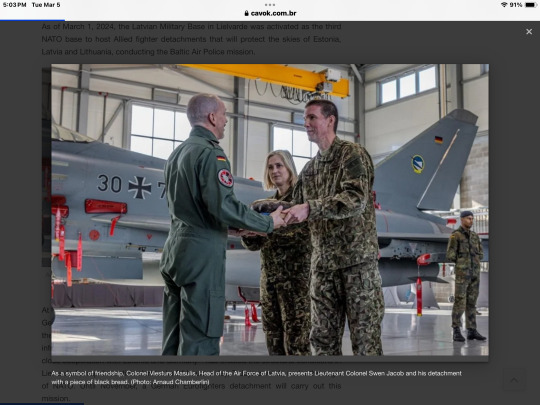
As a symbol of friendship, Colonel Viesturs Masulis, Head of the Air Force of Latvia, presents Lieutenant Colonel Swen Jacob and his detachment with a piece of black bread. (Photo: Arnaud Chamberlin)
At a ceremony held on March 2, 2024, representatives of Latvia, Canada, Estonia, Germany, Lithuania, Poland, Spain, the United States and NATO officially inaugurated the role of the base in NATO's regional Air Police stance. Due to the runway and infrastructure works at Ämari Air Base that will last until the end of the year, Latvia - in close cooperation with Estonia and Germany - has created the structural conditions in Lielvarde for rapid reaction alert tasks 24 hours a day, 7 days a week, under the aegis of NATO. Until November, a German Eurofighters detachment will carry out this mission.

— Team Luftwaffe (@Team_Luftwaffe) March 1, 2024
An inspection team from NATO's Combined Air Operations Center (CAOC) in Uedem, Germany, responsible for supervising the Alliance's Air Policing throughout northern Europe, has officially certified that the command and control process is in place in Lielvarde - from the first alert to the launch of the fighters and the presentation of the final mission report.
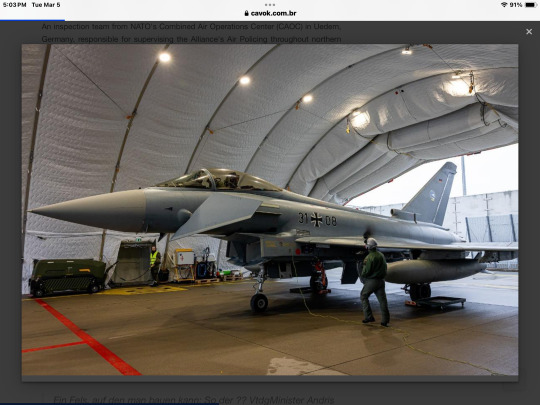
"This is a memorable day for Latvia and NATO. For the first time, NATO Air Policing will be carried out from the Lielvarde Air Base," said Latvian Defense Minister Andris Spr? ds. "We are grateful to all the Allies who contributed their forces to this mission of shielding the airspace of NATO and our people. Air domain is essential for the deterrence and defense of the Allies. The ability to carry out the mission from various locations clearly shows that NATO's integrated air and anti-missile defense can be agile, fast and credible in the defense of our airspace,” he added.

— Team Luftwaffe (@Team_Luftwaffe) March 2, 2024
"For almost 20 years - since Estonia, Latvia and Lithuania joined NATO in 2004 - the principle of collective defense has been implemented in the Baltic States, and this mission has now physically reached Lielvarde, which means that NATO has three operational bases for detachments. - one in each Baltic ally," said Major General Harold van Pee, commander of the CAOC Uedem. “Both Latvia and Germany did an excellent job in quickly preparing the air base for combat aircraft jobs, as was demonstrated yesterday, when the German detachment managed to make its first alert a few hours after formally assuming the status for the first time,” he added referring to the first German takeoff from Lielvarde to intercept Russian military aircraft flying over the Baltic Sea.

— Team Luftwaffe (@Team_Luftwaffe) March 1, 2024
The ceremony was another opportunity to highlight the collective effort of the Allies in the region. “In the current ever-evolving security environment, NATO's Baltic Air Policing mission plays a crucial role in deterring potential threats, safeguarding the integrity of airspace and promoting regional stability,” said Colonel Viesturs Masulis, Commander of the Latvian Air Force. "It serves as a visible demonstration of our collective determination to defend ourselves against any threat; therefore, we have the honor of receiving and hosting the German Luftwaffe while it operates its Eurofighters from Lielvarde Air Base, ensuring safe skies. I would like to thank the Polish Air Force for its support of the Ämari Air Base mission in Estonia. Thank you for helping to protect our airspace during the last few months,” he added.
With the activation of Lielvarde Air Base, Latvia allows NATO to continue to use two air bases for Air Police in the region. In the meantime, Ämari Air Base will be used for the deployment of Germany's Detachable Control and Reporting Center, which, from mid-March to the end of June 2024, will increase NATO's surveillance and control capacity in the Baltic Sea region. During this period, German air traffic controllers will be integrated into the control and communication centers in Estonia, Latvia and Lithuania.
Tags: Military AviationEurofighter TyphoonLuftwaffe - German Air ForceNATO - Air Police Mission
Sharing
tweet
Fernando Valduga
Fernando Valduga
Aviation photographer and pilot since 1992, he has participated in several events and air operations, such as Cruzex, AirVenture, Dayton Airshow and FIDAE. He has works published in specialized aviation magazines in Brazil and abroad. He uses Canon equipment during his photographic work in the world of aviation.
Related news
MILITARY
Finland approves deployment of the F-35A assembly line at Patria
04/03/2024 - 23:18
BRAZIL
IMAGES: How was the farewell of the C-130 Hercules at the FAB, after almost 60 years
04/03/2024 - 18:36
MILITARY
VIDEO: Turkish manufacturer tests Akinci drone with high-precision missile systems
04/03/2024 - 14:30
MILITARY
IOMAX prepares updated Grand Caravan aircraft for ISR missions with the Royal Jordanian Air Force
04/03/2024 - 13:00
MILITARY
Pentagon will suspend V-22 Osprey flight ban this week
04/03/2024 - 12:00
INTERCEPTIONS
Hours after taking over NATO mission, German Eurofighters intercept Russian aircraft
04/03/2024 - 09:00
3 notes
·
View notes
Text
Latvian Volunteers in the German RAD have Military Training, 1944

5 notes
·
View notes